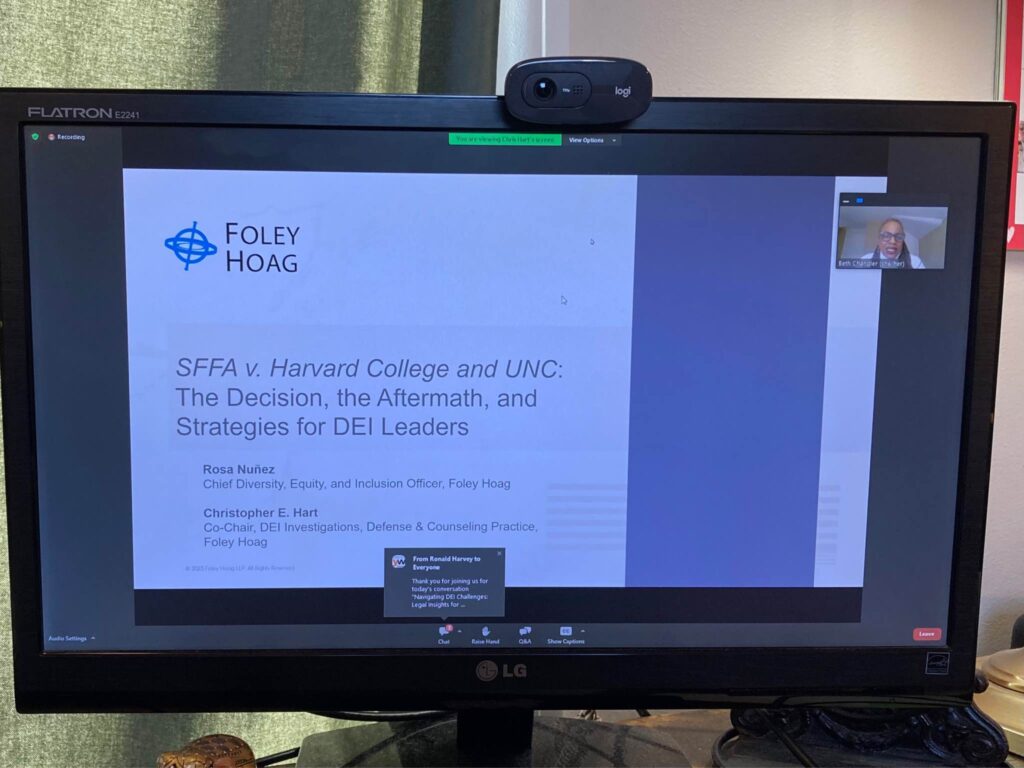
I’m not a lawyer, and this isn’t legal advice, BUT: daaaang y’all, this morning’s YW Boston webinar on “Navigating DEI Challenges: Legal Insights for Moving Forward in the Face of Resistance” was fricking FIIIIIIRE. Sharing my quick takeaways here because I’m involved with at least 3 organizations that need this info and I bet you are too?
CONTEXT: following last year’s Supreme Court of the United States (SCOTUS) decision striking down race-conscious admissions in higher education, what’s the future of Diversity, Equity, Inclusion, and Belonging (DEIB) initiatives in other settings?
HEADLINE: DO NOT STOP OUR DEIB WORK! It’s still very much OK and legal, just have to make sure that it is clearly tied in to our mission, core values, bottom line. Whether you’re a company or a nonprofit, get clear on WHY diversity/inclusion/etc is crucial to your work, not just on a vague “it’s a good thing” basis but exactly how it is necessary to your organization’s success.
SCOTUS is directing us towards a so-called “color-blind” standard (insert eye roll here). BUT it is very possible to make that consistent with efforts to increase INCLUSION and BELONGING – so you have an organizational culture where EVERYONE can actually thrive.
It may be “risky” to have employment/recruiting etc. targets and policies that advantage one group on an identity basis if that means that another group is automatically disadvantaged – if it’s a zero-sum situation where there are only so many jobs or whatever. It also may be risky to propose *solutions* that are based on identities, even when we can point to *problems* that are based on identities.
BUT, we can still legally collect and analyze data that tell us whether reality is matching up with our mission/values/WHY for DEIB, and then use strategies that make us more INCLUSIVE of people who advance the WHY. [Personal sidebar – this reminds me of the classic example of how sidewalk curb cuts required by the ADA for wheelchair users actually make life easier for anyone with a rolling suitcase or a baby stroller – that’s known as “inclusive design.”]
For instance, eliminating unnecessary education requirements removes a barrier for historically disadvantaged groups AND FOR EVERYONE, so yay, that’s fine. It’s also fine to focus on building a pipeline of the folks we need for our WHY by working with schools/partners/etc. that serve those communities – as long as we’re not explicitly shutting out other candidates. Same for affinity groups at work, it’s less “risky” to open those up to allies as well as folks of a specific identity, but we can still have affinity group charters that tie into our WHY to make sure they don’t get derailed.
And about the idea of “risk”: organizations should decide how much risk we’re willing to accept! Just because there’s some risk to a choice doesn’t mean we should automatically avoid it.
[Personal sidebar – decades ago, I was a paralegal at a civil litigation law firm, and the whole company went on a whitewater rafting trip. The lawyers’ favorite part of the whole experience was when the rafting company made us all sign liability waivers. “Hahahaha!” laughed the partners. “I could throw this out of court in 2 minutes!” You can’t stop anyone from suing you, they said. “Anyone can sue anyone for anything anytime.” You just want to be okay with your odds that if you’re sued, YOU’LL WIN.]
[Personal sidebar, part 2 – for those of us who sit in positions of power, and especially if we’re white, I believe very strongly that we need to reassess our understanding of what “risk” means. When we decline to take a risk… that usually means we are by default assigning the risk to someone else with less power. We’re avoiding the threat of losing some of our power, money, or privilege – and thereby saying that folks who currently have less of those things need to either stay that way (ie they have a 100% risk of remaining in an unfair situation) or risk losing more of whatever they do have, in order to fight for what’s fair. THAT’S NOT OKAY. People with power must accept our proper share of risk.]
Bottom line from the attorneys leading this amazing webinar: “The work is worth fighting for. People are counting on you!”
DEIB work is not gonna stop, and neither should we. Happy to talk through these notes with you, just ping me. Onwards, together, always. ![]()
![]()
![]()